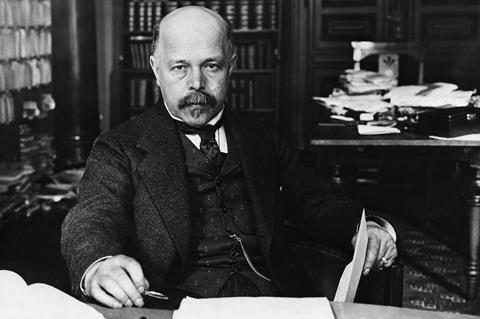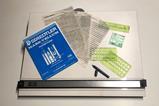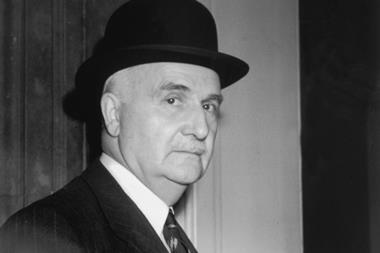The practical side of a theoretical legend

This column was born out of a fairly silly premise. What was needed to make a scientist famous? Was it the award of a great prize, the discovery of some fundamental law, or perhaps the development of a remarkable piece of kit? We settled for the kit, on the grounds that some pieces – the ‘Bunsen’ for example – are so well know that the name had become a parodic metaphor for the entire experimental enterprise.
And yet there are some people who don’t fit this mould. Yes, they have a piece of apparatus. Yes, they have a famous equation. And yet perhaps their greatest achievement is not often connected with them. One such was Walther Nernst.
Nernst was born in what is today Poland and his education involves something of a who’s who of science. He studied in Zurich and Berlin but eventually ended up in Graz, where Ludwig Boltzmann was based. With his research adviser, Albert von Ettinghausen, Nernst discovered a subtle thermoelectric effect. But he wrote up his thesis in Würzburg in the electrochemist Friedrich Kohlrausch’s lab. His reputation took him to Leipzig where Wilhelm Ostwald had recruited Svante Arrhenius and Jacobus van ’t Hoff to develop physical chemistry into an independent discipline on a par with organic, inorganic and analytical. Here Nernst began studying electrochemistry in earnest, never losing sight of the big thermodynamic picture.
Eventually, Nernst was appointed to a chair in Göttingen where he wrote his book Theoretical Chemistry. In the book he refers to two cornerstones: Avogadro’s hypothesis, which he describes as a ‘horn of plenty’, and the laws of energy. But his thinking about the thermodynamic relations would lead him to a very profound idea: that the free and internal energies would converge at absolute zero. First referred to as the Nernst theorem, it later became known as the third law of thermodynamics and earned Nernst the 1920 Nobel prize in chemistry.
But far from being just a theoretician, Nernst was highly active in the lab. He also speculated on big problems including the conversion of nitrogen into ammonia – this led to robust discussions with Fritz Haber who would eventually crack the problem. He also invented an ‘improved’ electric light, the filament coated in rare earth oxides, in essence an electrically driven version of Carl Auer von Welsbach’s gas mantle. The sale of this patent made him rich, although in the end the idea went nowhere.
Nernst was finally appointed professor in Berlin, where the arrival of Max Planck’s quantum theory and Albert Einstein’s theory of heat capacity led him to do experiments at very low temperatures in a chaotic lab that his students described as being in a ‘state of maximum entropy’.
In 1909 he asked one student, Arnold Eucken, to develop a low temperature calorimeter. Their device featured a central sample holder suspended in vacuum by means of slender heating wires inside a silvered outer jacket. The vacuum was provided by one of Wolfgang Gaede’s new mercury-filled rotating pumps. The jacket was placed in a cooling bath of liquid air or dry ice/alcohol according to temperature range. At first the central sample holder was made of silvered glass, but the thermal conductivity inside the holder was so low that temperature equilibration was very slow. Hoping to improve thermal conduction, Eucken tested the system when filled with hydrogen gas. When this didn’t work he redesigned the holder in copper sheet, with six thin copper strips soldered inside. A platinum wire, which doubled as heater and resistance thermometer, was carefully bent into a zig-zag pattern between each set of copper strips and insulated from them with wax paper.
Nernst did the low temperature work himself
With the sample loaded and the system under high vacuum, heating would begin in 30-second steps, the current monitored with a Weston ammeter and a Siemens–Halske voltmeter. In this way the heat capacity of the material could be meticulously measured across a wide range. Nernst was delighted.
While two of his students used a slightly simpler calorimeter to determine the average heat capacities of about 20 different materials, Nernst did the low temperature work himself, aided by his lab assistant Franz Pollitzer. There is a palpable excitement in the Nernst papers. Every material he tested showed the progressive drop in heat capacity at low temperature, confirming and significantly extending the earlier measurements made by James Dewar, his own theorem, and Einstein’s prediction.
Nernst would prove politically skilful too, convincing the Kaiser to establish the Kaiser Wilhelm Society (today Max Planck) to support research. When the first world war broke out, Nernst studied explosives in his lab and proposed the use of tear gas to incapacitate the enemy. After the war Nernst continued his science, but the rise of the Nazis changed everything. His daughters had married Jews and emigrated. He refused to sign forms about his racial origins and tried to support and protect Jewish colleagues, not least Franz Pollitzer who fled to Paris (and would later be deported to Auschwitz and murdered). Eventually Nernst was fired and he retired to his country estate until his death early in the war.
Nernst’s legacy and moral courage are undeniable. But all almost any chemist remembers is Nernst’s equation (with a little blurriness over the quotients). Surely the third law should count for something?

















No comments yet